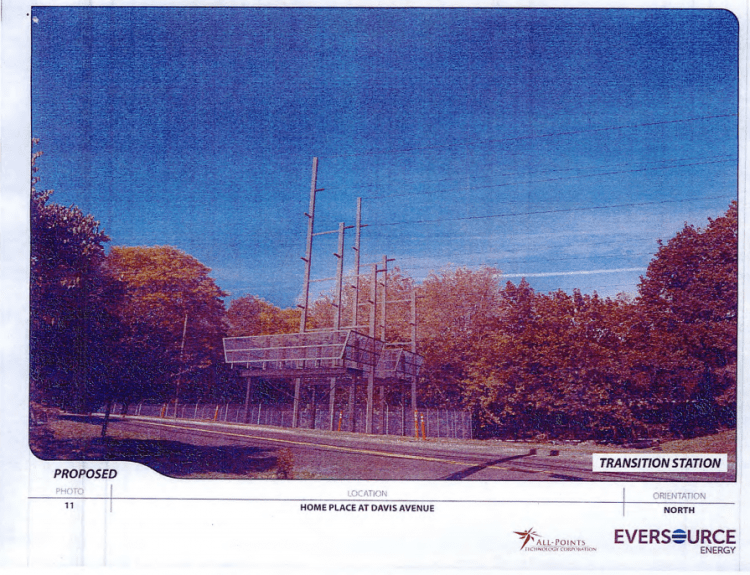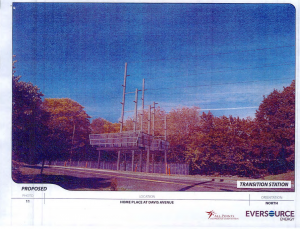

In a letter and 26-page report sent to the Connecticut Siting Council, Greenwich Director of Planning and Zoning and Town Planner Katie DeLuca laid out four major objections the town has to Eversource’s proposal to build a new substation at 290 Railroad Avenue and lay underground transmission lines through sections of Bruce Park.
The report, dated November 23, states, “Based on our continuing education on this subject, we feel very strongly indeed, that additional investigations must be undertaken by the utility before any approvals to proceed are contemplated.”
Further, the town claims that communication between them and Eversource “never reached conclusion” and says that any suggestion that the town is in favor of lines through Bruce Park or agreed to such route is incorrect.
Frank Poirot, a spokesman for Eversource, said the siting council will determine what happens next. “The review is in the evidentiary phase of the Siting process, and the council determines the next steps for our proposal,” he said via e-mail.
The siting council met Tuesday, Dec. 1 in New Britain for an evidentiary hearing, and plans to meet again on Jan. 12 before it makes a decision, expected in the first quarter of next year.
In a letter to the siting council, First Selectman Peter Tesei writes, “At present, nothing offered by the Connecticut Light and Power Company doing business as Eversource Energy, confirms the necessity of such a project, which as proposed, is expected to cost $140M and would dramatically affect electric rates in the State of Connecticut (already the highest in the contiguous 48 states). I respectfully urge you to withhold any support of such an undertaking until a careful, thorough review of the project, based on the most current and accurate data is completed.”
DeLuca gave her insight on the technical complexity of the issue and raised concerns about cost effectiveness and the failure to consider alternative options for energizing the homes and businesses of Greenwich.
“If you told the average citizen in Greenwich that $140 million was going to be spent on increasing the reliability of the power system in town, on the face of it they would, I’m sure, be quite happy,” DeLuca said. “But if you told them that none of that increased reliability would be for where they really need it, which is well documented to be from power outages during storm events, I’m sure they would be much less happy.”
She continued, “The construction of a new substation on Railroad Avenue would in no way improve the restoration of electricity owing to a storm event.”
The town then outlined four primary arguments against Eversource’s proposal, citing questions on statistics and concerns for existing and surrounding bodies of land and water.

The first point DeLuca makes in her lengthy report is that there are “very viable options to meet the utility’s claimed needs, none of which involve Bruce Park.”
“To the Town of Greenwich, Bruce Park is the equivalent of what Central Park and Prospect Park are to New York City,” DeLuca said in the report.
DeLuca adds that other options, such as tracing the Metro-North route, haven’t been looked at closely by Eversource.
“It seems Eversource is still unwilling to examine alternate designs, at least with the town, one of which would run the new feeders among the existing Metro-North railroad tracks,” DeLuca states in the report. “It is unfathomable to the Town that State controlled property, that support[s] this technology throughout the State, is being dismissed out of hand without proper consideration of such options.”
According to Eversource’s projections, by as early as 2017 Greenwich might use more electricity than the utility’s present system was designed to accommodate. However, consumption data no more recent than 2013 was used in its projections; the town bases its argument on Eversource’s more recently compiled statistics.
The numbers in question are Eversource’s projected need for a higher capacity of energy. Eversource’s projections have the town exceeding the system’s capacity by 6.8 percent in 2024. DeLuca argues that “based on the actual consumption data for 2014 and 2015 compiled by Eversource, it will not be until 2031 that the system will exceed its designed capacity.”
In her third point, DeLuca questions Eversource’s effort to remedy a small percentage overload in capacity with building a new substation on Railroad Avenue. She says, “To overcome a 6.8 percent deficiency, the utility is proposing a 100 percent increase in their available capacity.”
“If one wants to get from point A to point B, should the taxpayers pay for the Ferrari when they could just take the effective Honda?” DeLuca added.
Finally, DeLuca brought up Eversource’s cable technology, which would be used as insulation for the cables running through and underneath Bruce Park, connecting the Cos Cob station and the proposed Railroad Avenue substation.
She states that Eversource proposes using technology that “employs a petroleum-based fluid to act as insulating means for the 115kv cables.

“Installing these feeders would necessitate digging up Bruce Park, most likely blasting rock and permanently removing trees,” DeLuca stated in the report. “The proposed cable system can leak, as evidenced by multiple examples of fluid spills of many thousands of gallons of this product, the vapors of which the manufacturer states one should not even inhale.”
According to Eversource’s proposal to the town, about 2.3 miles of cable would run between Cos Cob and Railroad Avenue, containing over 100,000 gallons of the fluid.
“It would be hard to envision the residents of the Town of Greenwich, or any other municipality, readily embracing a request from say the likes of an Exxon Mobil, to build a conveyance system for upwards of 100,000 gallons of liquid petroleum through their streets. In this particular case, the proposed route of the fluid-filled feeders would take it directly past one of the most populated children’s playgrounds in the entire Town of Greenwich”—Bruce Park Playground—“located on Museum Drive.”
The town also questioned certain conclusions in Eversource’s proposal, such as whether Greenwich’s electricity requirements could be compared with Stamford’s in any meaningful way.
“We have no reason to dispute that the application’s claim that, ‘The Southwest Connecticut area is the largest load within Connecticut,’” DeLuca said. “However, the changes to the Greenwich ‘landscape’ over the last three decades, does not mirror Stamford. We believe much of the forecasting for potential electric consumption in Greenwich has been influenced by what has taken place in Stamford and other areas, rather than a careful analysis of what has taken place in Greenwich.”
The siting council will continue evidentiary hearings in the coming months.
If the proposed siting plan is approved, a development and management plan will be submitted to the CSC for approval in the second quarter of 2016. Construction would begin in the fall of 2016, pending all necessary approvals. An estimated in-service date is set for the second quarter of 2018, but conflicting sides have pushed back the timetable by several months already.




